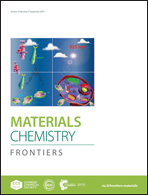Optimization of oxygen evolution dynamics on RuO2via controlling of spontaneous dissociation equilibrium†
Abstract
The general design strategy for excellent catalysts has been well established by the Sabatier principle, e.g., moderate bond strength between the catalyst surface and the reactant/product. From the viewpoint of reaction kinetics, it is possible to modify the rate determining step through separately accelerating the adsorption and dissociation of intermediate products. In this research, we have demonstrated that OER kinetics for RuO2 could be effectively promoted with the precise control of the reaction kinetics by optimizing the equilibrium of dissociation and recombination of water molecules. It is found that increasing the concentration of OH− in the electrolyte contributes to the formation process of the peroxy species, Ru–OOH*, while the increase of temperature is helpful for the deprotonation process from a stabilized configuration of the peroxy species. With faster rate determining steps, RuO2 shows excellent OER activity and stability under high temperature and concentrated basic electrolyte conditions. It is meaningful for accelerating the practical application of hydrogen production from electrolysis of water. And this research will provide a new perspective for the study of catalytic reactions, not just limited to the OER.

- This article is part of the themed collection: 2019 Materials Chemistry Frontiers HOT articles


 Please wait while we load your content...
Please wait while we load your content...